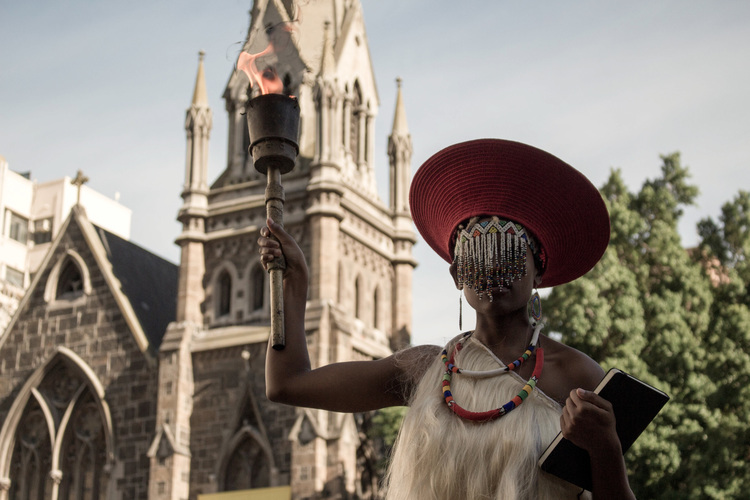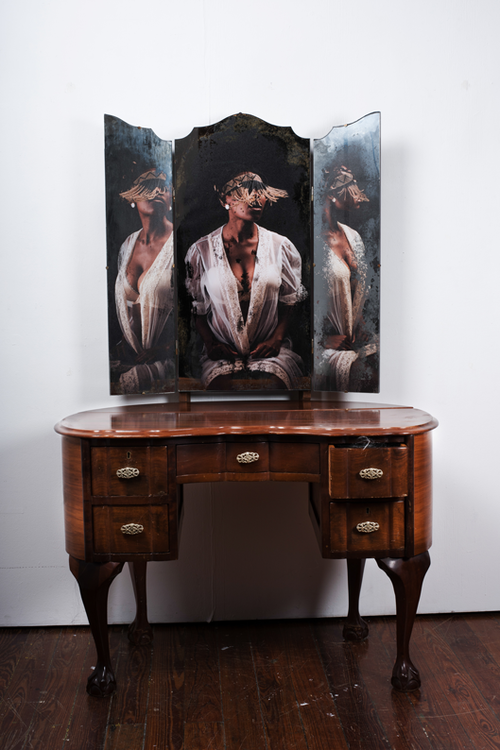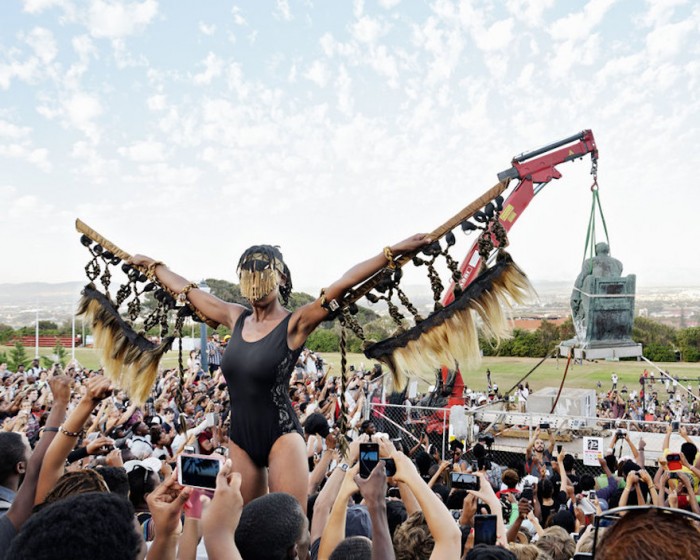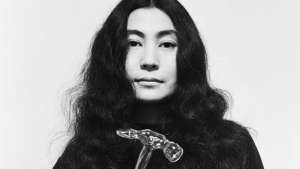When Sethembile Msezane talks about her work it’s from the perspective of a messenger.
Her subjects, she says, come to her in her dreams, touching her spirit, calling to be conjured. She answers in dress and performance, embodying the women or the symbols that choose her.
“In most of my work my identity, my face is concealed and that’s particularly because when I am performing or when I’m making work about another woman, I am in essence taking on their persona. I am connecting with them spiritually.
“I am trying to embody them spiritually by using my body. So my identity as Sethembile is not necessarily something that I would like my audience to focus on. That’s why I wear a beaded veil.”

She adorned the beaded veil and feathered wings to embody the Zimbabwean bird Chupungu on the day that a statue honouring Cecil John Rhodes was removed from the UCT during student-led protests.
She stood on the plinth for four hours fighting blue feet and heat stroke as the crowds gathered in song and dance to mark the momentous occasion.
Chupungu is one of eight soapstone birds that were taken from Zimbabwe during the colonial era. All of the birds have since been returned save for Chupungu which is still in Rhodes’ estate today.
The mythological belief is that social unrest will continue until all eight birds are returned to Zimbabwe. This is the mythology that Msezane channelled when the statue was removed in 2015.
As the Rhodes statue fell, she lifted her wings in a gesture that gave many people hope that Africa would overcome its colonial past.
The picture of that moment would make national and international news. It framed South Africa’s student protests in a way that deviated from the norm. It felt like solidarity more than the destruction reported in the mainstream media at the time.
But for the Cape Town-based and KwaZulu-Natal-born artist, her mission to subvert colonial ideologies begun long before.
In 2013, her Public Holiday series demanded representation for the black female body in public spaces.
“I guess the departure point for me was, I think, in 2013 when I had been living in Cape Town for about five years at the time. I still felt a kind of displacement. I felt like I didn’t belong.
“Walking down the street in the city that was now my home, I couldn’t identify with the symbols and the figures that were supposed to represent a kind of national identity. These [monuments and statues] were white men, you know? They were colonial, they were Dutch, Afrikaner nationalist men.”
In all of this I couldn’t see anything African; I could not see anything that was women. I could not see anything that was like my mother and my aunts, or women that I knew. So for me, it was a task of reclaiming histories that had been omitted from public spaces. That’s how I came to perform and use my body.”
The history of the black female body carries a unique kind of weight. “It’s loaded in history and politics and issues that concern power, race, gender and class,” says Msezane. “So, I suppose, through using my body as a vehicle I am speaking about all of those things indirectly while still speaking about the narrative about the women I have chosen – or she has chosen me to represent at that particular time.”
In the Public Holiday series, she started by looking at the significance of different public holidays. For instance, on Freedom Day, Msezane performed as the embodiment of the statue of Liberty. On Workers’ Day, she adorned the uniform of a South African factory worker.

By doing this she became the black female statues that are missing from the African landscape and juxtaposed these figures with the permanent remnants of our colonial past.
“The performances were quite ephemeral unlike these permanent statues that are in a landscape that’s ever-changing. I kind of liked that temporariness of those performances and like I was talking about this archive that has been somewhat lost,” she explains.
Her latest project, however, has found a more permanent home in gallery spaces around Cape Town. Kwasuka Sukela combines performance, particularly that of Chepungu, photography and sculpture.
“I work with performance and work with photography but now I also turn these portraits into sculptures that are furniture. So mediums often intersect.
I use sound within these sculptures as well and depending on what I am trying to say I choose the medium that is best to articulate those feelings and those experiences and those histories. So my work becomes sensory and immersive.”

When she made the switch from public plinth to the less public gallery space, Msezane found interesting things about the way men and women are revered.
To honour men, we erect bold statues in the public realm while women are often only celebrated privately in the home.
Using photo albums fished out of old wardrobes, Msezane embodied these women in portraits which were then embedded in furniture.
She was inspired by the Victorian furniture that her mother revered in her childhood home.
“The furniture became a part of this colonial fabric that was woven into this African locale that I was talking about. How we have these colonial histories that are a part of our history and we can’t escape them but at the same time as people we are trying to find our own identities and to be very present.
In private spaces you get to be human again, you humanise yourself. It’s a place where you can love, feel love and you can fall in love and you can take care of yourself. And so, that’s how I used the private and the public domain to speak about all of these subject matters.”
Msezane's work is currently on display at Africa’s first museum of contemporary African art, the Zeitz MOCAA.







